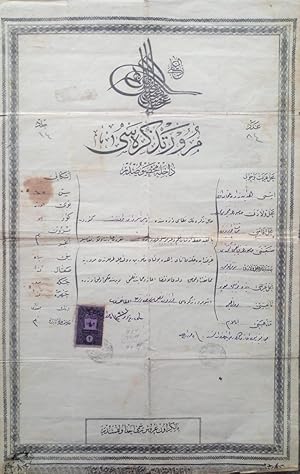Descripción
Original autograph 'Mürûr tezkîresi' given to Kayikçi kethüdasi Hidayetzâde Osman' for his travel to Rize by the Ottoman Census Directorate of Trebizond. 4327 cm. In Ottoman script. With special Ottoman period-stamp '2 Kurus'. Two seals on paper dated 'fî sene 5 Haziran [1]322' and '[1]324'. [i.e. AH 1906 and 1908]. Folded. Some stains on paper and minimal holes. Otherwise a good copy. There were several restrictions upon the travelling inside the state during the Ottoman Period. Both local residents and foreigners had to get some official documents called as "yol hükmü (hereafter, the route pass)" in 16th century and "Mürur Tezkiresi (hereafter, the trip permission)" in the 19th century to travel inside the state. The administrators of the settlements in which the visitors would pass were assigned with authorities in the route passes. In this regard, administrators were ordered to help the ambassadors of the foreign states, traders, religious people, to protect them, and not to disturb them with such reasons as collecting taxes, as well as to assist them in getting food and drinks. In the trip permissions, the information on the name of the father, nationality, address and travelling route of the travellers were included. During the period in which the photos didn't exist or weren't prevalent, some information on the age, height, and physical descriptions (beard, moustache, eye color, etc.) were included in the document. The owners of the trip permissions would show the documents to the local administrators or officers upon their arrival, and the authorities would stamp, signed and dated the back of the documents while they were leaving the settlement. In those regions where epidemics were occuring, the back of the travellers' documents were written that they didn't have any diseases while leaving the state. The "mürur" trip permission was redesigned along with the modern state organization structured by II. Mahmud period. Passport regulations inside the country were institutionalized thanks to "Mürur Nizamnameleri" in this period in which there weren't official passport regulations in practice. The Rum Riots in 1820s and the abolition of Janissary corps of the Ottoman Empire in 1826 affected the mürur practices and its supervision. Following the Rum Riots, there were some claims that several spies existed among the Rums in Istanbul, so the Rums who lived in the settlements of Istanbul were made to pay bail after their numbers were determined. It was especially declared that those without the trip permission couldn't enter Istanbul, and even couldn't go to Anatolia. In addition to the Rum Riots,an emergency state was declared due to the start of Janissary corps' riot, and a great number of Janissary were killed or exiled. On the other hand, it was thought that those exiled out of the state might try to come back as they were accustomed to earning their life in Istanbul, and so "Mürur Nizami" practices were put into effect. Those using ferries or sailing ships, on the other hand, needed to submit their passports to the captains in order to get a permission form (pusula) in return for it. After the captains delivered the passports to the officers, those who came to Istanbul would get their passports back in 24 hours, while those outside ?stanbul would submit the permission form and take their passports. If they intended to stay, they had to predicate where and how long they will stay. When the visitors couldn't submit their passports or give a reasonable excuse, they would be deported from the Ottoman territories. In the event of determining a fake passport or travel document, those would be deported, following the contacting with the diplomatic representatives of the other countries. Those who showed their passports wished to stay in the Ottoman Territories needed to get a residence permit from the diplomatic representatives [.] (Source: UNEARTHING THE PAST: PASSPORT REGULATIONS IN THE OTTOMAN EMPIRE, Burak Eryilmaz).
N° de ref. del artículo 052696
Contactar al vendedor
Denunciar este artículo
